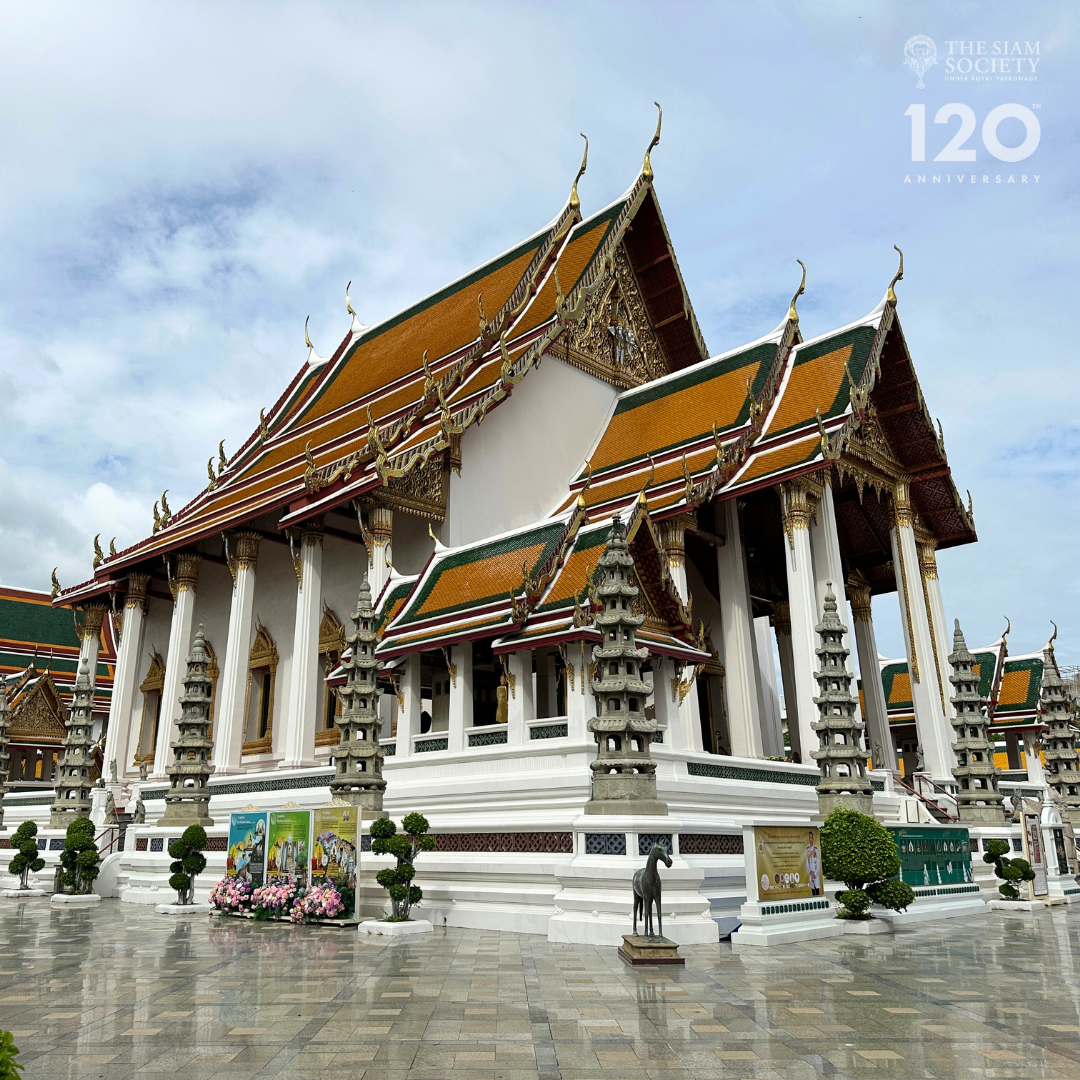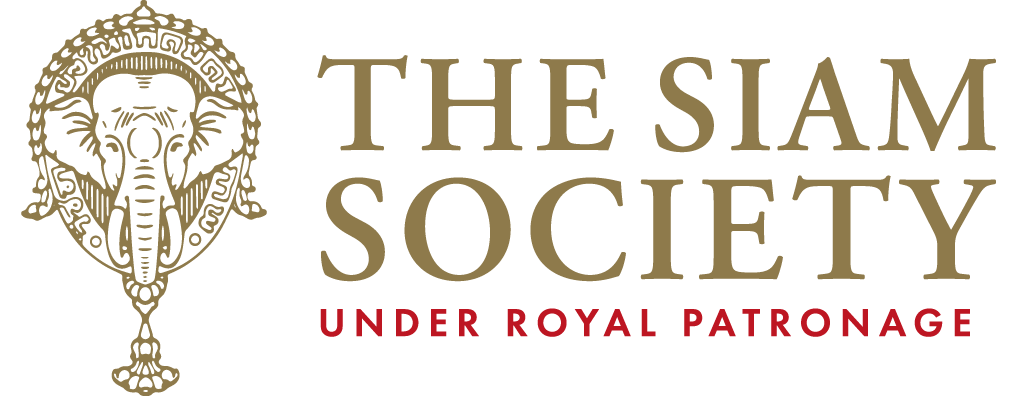
The Siam Society’s Study Trip: เปรตวัดสุทัศน์ มีที่มาอย่างไร
สยามสมาคมฯ ได้จัดการศึกษาสัญจรไปยัง วัดสุทัศนเทพวราราม วัดราชประดิษฐ์ และวัดราชบพิธ เมื่อเดือนมิถุนายน 2567 ที่ผ่านมา การเดินทางครั้งนี้ทำให้เราได้เรียนรู้เรื่องราวที่มาของเปรตวัดสุทัศน์ที่อยู่คู่กับสังคมไทยมาอย่างยาวนาน
In June 2024, The Siam Society organised a one-day study trip to visit three Royal Temples which were Wat Suthat Thepwanaram, Wat Rachapradit, and Wat Ratchabopit. During this visit, we got to learn more about the origin of the Preta of Wat Suthat legend that has been in Thai society for a very long time.

ภายในพระอุโบสถของวัดสุทัศน์ มีภาพจิตกรรมฝาผนังฝีมือช่างสมัยของพระบาทสมเด็จพระนั่งเกล้าเจ้าอยู่หัวประดับตกแต่งอยู่ตามผนังด้านต่างๆ และเป็นที่ประดิษฐานของพระพุทธไตรโลกเชษฐ์ เป็นพระพุทธรูปปางมารวิชัย ทั้งพระอุโบสถและพระประธานล้วนสร้างขึ้นในสมัยของรัชกาลที่ 3
Inside the ubosot of Wat Suthat, there are murals painted by craftsmen from the reign of King Rama III decorated on the walls. It is also the enshrinement of the Phra Phuttha Trai Lokkachet. Both the ubosot and the main Buddha image were built during the reign of King Rama III.

ที่วัดสุทัศน์มีเรื่องเล่าขานกันถึงเปรต ซึ่งเป็นผีตามความเชื่อในหลายศาสนาของตะวันออก เรื่องเล่าพื้นบ้านของสยามมักบรรยายภาพของเปรตว่าเป็นผีหิวโหยตัวสูงตระหง่าน มีรูปร่างผอมแห้ง และมีเสียงโหยหวนอันน่าสะพรึงกลัว อีกทั้งยังมีเรื่องเล่าปากต่อปากว่าเคยมีผู้พบเจอเปรตที่ปรากฏหน้าวัดแห่งนี้ในตอนกลางคืน
At Wat Suthat, there are stories and myths about “Preta”, also known as a hungry ghost, which is a type of supernatural being described in several eastern religions. Preta was frequently portrayed in Siamese folklore as a towering, hungry ghost with a thin body and a terrifying howl. There are also word-of-mouth stories of people encountering a Preta that appeared in front of this temple at night.

แท้จริงแล้วเปรตวัดสุทัศน์มีที่มาจากภายในพระวิหารของวัดนี่เอง บนเสาด้านข้างขององค์พระศรีศากยมุนี มีภาพจิตรกรรมซึ่งเคยมีชื่อเสียงมากในอดีตภาพหนึ่งประดับอยู่ เป็นรูปเปรตนอนพาดกาย และมีพระสงฆ์ที่กำลังพิจารณาสังขารยืนรายล้อมอยู่ ภาพจิตรกรรมนี้ก็วาดขึ้นในรัชสมัยพระบาทสมเด็จพระนั่งเกล้าเจ้าอยู่หัวเช่นเดียวกัน
In fact, the myth of Preta of Wat Suthat originated from within this temple’s wihan. There is a very famous painting in the past on the pillar beside Phra Sri Sakyamuni, the main Buddha image in the wihan. It is a painting of a lying preta surrounded by standing monks who are contemplating the body. This mural was also painted during the reign of King Rama III.

ภาพถ่ายเสาชิงช้า จากหนังสือ The Thai Peoples, Book I โดย Major Erik Seidenfaden
A photograph of the Giant Swing in The Thai Peoples, Book I by Major Erik Seidenfaden
นอกจากนี้ เปรตวัดสุทัศน์อาจเป็นความเข้าใจผิดของผู้ที่มองเห็นเสาชิงช้าที่ตั้งอยู่ด้านหน้าวัด ในช่วงเวลาเช้ามืดหรือทัศนวิสัยไม่ดี แล้วสำคัญผิดว่าเป็นเปรต
The Preta of Wat Suthat might also be a misinterpretation for those who saw the Sao Chingcha, or Giant Swing in front of the temple during the early morning hours or when visibility is poor and thought it was a sight of a Preta.

ภาพวาดสมัยศตวรรษที่ 12 ของเปรตในอารยธรรมญี่ปุ่น
A traditional image of a Preta from late 12th-century Japan
ความเชื่อเรื่องเปรตสามารถพบได้ในศาสนาฮินดู พุทธ เต๋า และศาสนาพื้นบ้านของจีน ภาพของเปรตยังแพร่หลายในวัฒนธรรมของอินเดีย บังคลาเทศ ศรีลังกา จีน ญี่ปุ่น เกาหลี เวียดนาม ทิเบต ไทย กัมพูชา ลาว และเมียนมาร์ เนื่องจากอิทธิพลของพุทธศาสนาและศาสนาฮินดู
The belief of Preta can be found in Hinduism, Buddhism, Taoism, and Chinese folk religion. Preta images are prevalent in the cultures of India, Bangladesh, Sri Lanka, China, Japan, Korea, Vietnam, Tibet, Thailand, Cambodia, Laos, and Myanmar due to the influence of Buddhism and Hinduism.
การศึกษาสัญจรเป็นกิจกรรมหลักของสยามสมาคมฯ จัดขึ้นภายใต้พันธกิจในการส่งเสริมความรู้ด้านวัฒนธรรม ประวัติศาสตร์ ศิลปะ และธรรมชาติวิทยาของประเทศไทยและของประเทศเพื่อนบ้าน
Study trips are a core activity of The Siam Society, in line with its mission to promote knowledge of the culture, history, arts and natural sciences of Thailand as well as those of its neighbouring countries.
